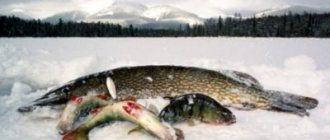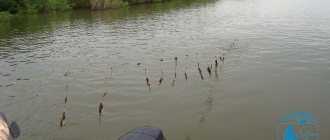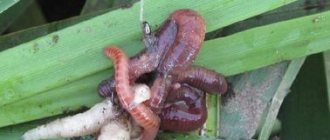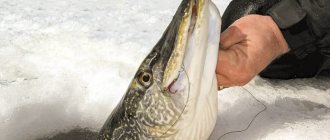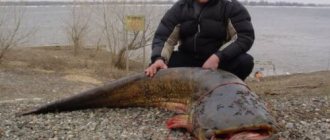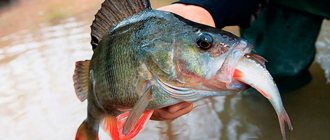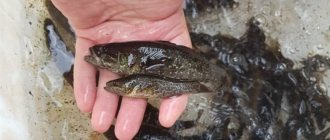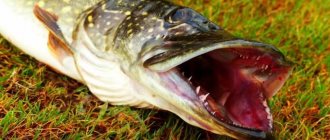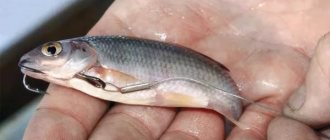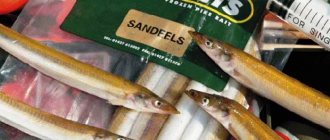Many fishing enthusiasts really like the method of catching predatory fish using live bait. There is still no consensus on the best way to attach live bait. Everyone tries to use their favorite method.
Fishing is especially exciting and romantic in winter, when a zherlitsa is used with great success. Inexperienced fishermen do not always manage to attach live bait correctly, as a result of which they may not catch a catch.
There is no single method for attaching live bait for all cases. This depends on many factors: the type of fish, its inherent activity, time of day, type of bait and live bait used. Let's look at several ways to mount live bait.
Live bait attachment behind the back
Perhaps this option can be called the most popular. You should attach live bait to the girder very carefully and carefully.
In this case, the fisherman should ensure that the ridge is not damaged. Most often, this method uses a tee, occasionally a single or double hook.
When fishing for pike, it is the triple hook option that is used. At the same time, a treble hook is not suitable for some types of live bait, an example is bleak.
If this fish is used as live bait, a special tee is used, which has specific hooks, where the size of one is much smaller than the others.
A thinner material is used to make this specific hook. This ensures a minimum of injuries, which allows you to maximize the life of live bait.
Interestingly, you don’t always need to buy such a hook in a special fishing store; many people successfully make it themselves at home from the means at hand.
First you need to stock up on a double hook, a winding ring and a hook with a ring.
First, the winding ring is equipped with a small hook. After this, a small vinyl tube is attached to the double hook.
Next, the prepared structure of the winding ring and hook is attached to the double. Live bait is attached to a small hook behind the back, while the large hooks remain open.
What bait do you use to catch which fish?
Even large fish prefer small live bait. Its standard size is from 7 to 9 cm. To know how to properly attach live bait to a pike or other predator, you will need to choose the appropriate form of bait. It is recommended to use live bait with a narrow body. What kind of predator is caught with what:
- when fishing for perch, it is recommended to use goby or loach as live bait;
- using a gudgeon, there is a chance to catch perch and asp;
- ruffe and crucian carp are often used in winter fishing;
- when fishing for perch and pike perch, they use perch as live bait;
- roach will attract any predator;
- Bleak in warm water awakens the appetite of many predators.
Bleak for live bait fishing
Bait bait by the gills
Fishermen use double hooks to place baitfish under the gills. The clasp that is attached to the leash is removable. A double hook is attached to the only remaining loop.
Live bait is mounted as follows:
- the end of the leash is placed under the gills on one side so that the loop is at the level of the baitfish’s mouth;
- a double hook is inserted through the loop and pulled through so that the loop remains at the top of the hook;
- the leader is pulled out until the hook reaches the mouth of the bait fish.
The problem, in the case of hooking, can arise when the leash is too soft or there is no leash at all. As an alternative, you can use a crochet hook that has a barb.
Such a hook is inserted into the fish’s mouth, a loop is attached to it, and then a double hook is inserted and pulled through.
Selection of hooks
The choice of hooks depends on many factors, as well as on the angler’s personal observations, which were formed over many years of searching for optimal options. Based on this, we can give some practical advice:
- When using fry you need to use double hooks (not double hooks). They can be made at home as follows: a smaller hook is soldered to the shank of the main hook. The live bait is attached to this small hook.
- For these purposes, installation with a leash up to 10 cm long is used. A small hook for bait is attached to the leash. As the main hook, you can use Owner or Gamakatsu hooks with a long shank.
- As a rule, hooks are selected depending on the size of the baitfish.
- To catch trophy specimens, it is advisable to use forged hooks (double or treble hooks). In addition to being more reliable, they cause fewer derailments.
- Any hook can be used, but live bait is usually attached to a thin, small hook.
Fishermen mainly use imported hooks, since domestic ones are not very reliable and can fail in the midst of fishing.
Live bait attachment by the tail
With this method, a thread is tied in front of the tail, and a hook is hooked onto it.
Instead of thread, you can use a simple rubber band or fishing line. In this case, the bait is not damaged at all, it remains active and tries to get rid of unnecessary devices in the tail part.
Some predators, with the exception of pike, are caught this way. When a pike intercepts the bait, its sharp teeth tear the rim made of thread or elastic.
Pike do not have the habit of attacking small fish from behind. She can easily spit out her prey if she suspects something unnatural, so often most of the pike’s bites go in vain.
How and when are live bait options used?
There are some subtleties when hooking a catch. Inexperienced fishermen hook as soon as it starts to “spin”, but in this case the actions should depend on the situation.
If the live bait is baited with its back, you need to hook it immediately. When a baitfish is caught in the lip or gills, it is worth waiting a little. It happens that the rotation of the coil slows down or stops altogether.
This may mean that the victim was grabbed by a predatory fish, which first rushed in some direction and then began to return back.
In this case, cutting will be of no use. In this case, the fisherman must slowly wind the line onto the reel and, sensing the right moment, make a hook.
The method in which live bait should be mounted depends on many circumstances:
- what kind of predatory fish the fisherman intends to catch,
- how active is she?
- what features does it differ from?
- what time is fishing planned, etc.
They try to catch perch or pike perch using live bait, which they put on their backs. The attack of pike is more sluggish; it often clings to the back of the bait. In such a situation, it is better if the bait is baited by the gills.
When swallowing live bait, the predator will be securely hooked. This method of attaching live bait is relevant for overly aggressive pikes.
During night fishing or when the girders are located at a distance from the fisherman, using live bait by the gills will be the best way.
It should be remembered that not all live bait can be attached using this method.
Roach and crucian carp attach well to the gills, but bitterling or bleak cannot withstand this method and quickly die.
A single, double or triple hook can be used to attach live bait.
The main requirement for them will be the presence of a sharp point and a long fore-end, which makes it easier to attach live bait. The thinner the hooks, the less trauma is caused to live bait.
The advantage of passing the leader through the gills is that there are no punctures in the body of the bait, so the bait remains alive for a longer time.
With this method, the stings of the hook located near the mouth cavity are directed towards the bait, so there is no need to hook the prey, since it swallows the hook on its own.
The only thing that needs to be ensured with this method is the presence of a soft leash, allowing the baitfish to take the appropriate position.
In another method, the end of the leader is passed through the gills and the hook is hooked through the back of the bait up to the dorsal fin. The disadvantage of this method is that the nozzle is damaged and does not last long.
When passing the sting through the nostril of the nozzle, the very end of it is equipped with a piece of cambric, an elastic band, and a plastic patch, in order to avoid the fish being torn off.
This must be done very carefully so as not to hurt the brain.
Catching pike perch on a feeder
Some fishermen use a steel leash, others do not. There is a category of fishermen who do not even install such leashes on pike, believing that they scare the attacking fish.
[THERE IS AN ANSWER] Which spinning rod is better for catching pike perch?
When fishing for pike perch, you can use a feeder, which contains bait for peaceful fish. It attracts small individuals, and they, in turn, attract a predator. We can recommend the following bait: breadcrumbs are mixed from crushed fish. You can use store-bought sprat or capelin as fish.
The duration between casts can reach 20-25 minutes. After casting, the rod is positioned so that the bait fish can rise from the bottom and remain in the water column.
A baitfish wounded by a hook, even with the most careful hooking through the “back” or by the tail, has little desire to behave actively in a reservoir and relatively soon becomes dead. Accordingly, from the point of view of the same pike, it no longer looks so “appetizing” that a lightning-fast bite would follow.
Alarmist
Blocked
K.A.P.1972
jeny256
Silala
A baitfish wounded by a hook, even with the most careful hooking through the “back” or by the tail, has little desire to behave actively in a reservoir and relatively soon becomes dead. Accordingly, from the point of view of the same pike, it no longer looks so “appetizing” that a lightning-fast bite would follow.
At the same time, if there is no result for a long time, the novice fisherman repeatedly checks the abandoned tackle or replaces live bait, which alarms the fish, for which any suspicious object is dangerous due to its innate instinct. Experienced fishermen who prefer to catch predators using casting rods with bait in the form of live bait have long learned to overcome such obstacles in a fairly simple way.
How to attach live bait - a tricky way
How to attach live bait with maximum fishing effect When baiting live bait, no matter on a double or tee, cunning advanced fishermen use a method of fixing it on the hook in the form of a kind of bridle.
Simply put, the hook is, as it were, attached to the body of the baitfish without a puncture. An elastic band for money or a piece of so-called aircraft model rubber (See picture) is ideal as a fastener.
What are the advantages?
With its help, the live bait is fixed on the hook and does not lose its viability until the very moment of the bite. Actively trying to get rid of the rubber band, he is forced to make movements in the water that imitate a sick or wounded fish. Of course, this behavior of the bait is very attractive to any predator.
In addition, predatory fish detects its prey not only with the help of its visual organs, but also by detecting even slight fluctuations in the water caused by the attempts of the baitfish to free itself from its bonds. Thus, a fry “restrained” with an elastic band is able to attract the attention of those fish that are located far enough from the place where the casting rod is cast.
At the same time, the fisherman is confident that the bait has not died, and therefore there is no need to once again remove the tackle from the water, thereby alerting freshwater “hunters” for small fish.
It turns out that this little trick successfully copes with two factors at once that influence the “lack of biting” of predators - violation of silence and constantly active live bait. This method of attaching live bait is also excellent when hunting for such freshwater “monsters” as snakeheads, catfish or burbot. You just need to slightly lengthen the leash with live bait so that it can actively move around the bottom, but not move far from its surface.”
The weight is attached to the anti-twist tube. The main fishing line is threaded through the tube, and a swivel is attached to the end of it. It should not go through the tube. A leash with a hook is attached to the second eye of the swivel. The length of the leash, depending on the fishing conditions, should be from 30 to 60 cm.
How to attach live bait to a tee?
With a treble hook the situation is different. It is not advisable to hook it on the lip, since in case of a bite it can break through it.
It is even more difficult to hook a treble hook onto the gills than a double hook. This method can only be used by experienced fishermen.
It is best to hook the bait behind the back with a tee, but do not forget about some features.
When a predator approaches the bait, the swallowing process does not occur immediately.
First of all, the predator will try to kill the small fish, then turn it around in order to swallow it later.
If you hook before the bait is swallowed, the predatory fish will not be hooked. When using a tee, some experience is required.
How to properly attach live bait for pike fishing in still water?
The most convenient attachment for live bait when fishing for pike in a still body of water is considered to be attached to the back. This method is used when fishing for pike near the bottom of a reservoir using a float rod.
In this case, even a sleeping bait will look natural to the pike, since it will be positioned horizontally.
This method allows the bait to attract the attention of pike in any season, however, this is only suitable for those reservoirs where the water is stagnant. Any current can cause the bait to be positioned in an unnatural position.
Live bait is attached in the following way: the fish is pierced with one of the hooks of the tee from the bottom of the base of the dorsal fin, and a small bead is used as a stopper.
The main mistakes when fishing with live bait
Frequent mistakes made by novice anglers can lead to a complete lack of bite. The most popular of them:
- using live bait exclusively of one species. There is a possibility that in a particular body of water a predator does not bite on these baits;
- incorrect attachment of live bait to the hook when fishing for a specific type of predator;
- if you attach a live bait with a single hook under the upper fin, it will quickly fly off;
- After a certain time, the baitfish dies, losing its attractiveness. It is recommended to periodically change the bait;
- early cutting. The initial task for pike is to kill the bait before swallowing it. Give her some time.
Originally posted 2018-04-24 09:54:15.
Source: rybalka.guru
What methods are there for baiting bait when fishing for pike perch?
Every fisherman tries to specialize in his favorite fish. However, everyone agrees that catching pike perch is very interesting, and the taste qualities of this type of fish are significantly superior to many other species.
Pike perch has always been considered a strong and worthy predator, to catch which a fisherman must have certain experience and skills:
- You can catch fish such as pike perch using live bait throughout the year, however, it bites best in the spring before spawning and after it ends. They usually go out overnight to fish for pike perch when it’s dawn or dawn. The gear for fishing with live bait will be a float rod.
- Usually they use a fishing rod with a rod of more than three meters. An inertial coil is not used. With such gear, fishing can be especially successful in places where the current is very quiet or there is no current at all.
- Often you have to use long casts to catch pike perch with live bait, so it’s a good idea to have a medium-sized sliding float on your fishing rod, with a carrying capacity of about three grams.
The sinker is placed at a distance of thirty centimeters above the live bait, which will allow the latter to be freer. In this case, it is quite acceptable to use a single hook, which will hold the bait well. The fishing line should be soft, diameter from 0.2 millimeters to 0.3. Similar gear is used for catching pike perch using live bait from the shoreline or from boats. - Live bait can be any young fish. Crucian carp and gudgeon have proven themselves very well. They stay attached to the hook longer.
- The live bait should be hooked behind the back, two centimeters behind the head. You can use a single, double or triple hook. It is necessary to ensure that the hook matches the size of the bait used. The hook should not exceed the size of the bait fish.
- During fishing, for greater safety, live bait should be stored lowered into the cage at a considerable depth, where the water temperature is lower. No more than a dozen live baits are launched into the bucket.
Adviсe
You should use different methods of hooking live bait, as well as different equipment, then compare the results and draw conclusions. Experience is important in everything.
For example, such an improved system as the Jardine tackle, which does not misfire, gives a good effect. It consists of several double hooks, which are assembled onto one leash, and small hooks are soldered onto the doubles.
To keep baitfish active longer, it is necessary to maintain a cooler temperature in the water where they are kept. Cold water contains more oxygen.
- If the water in the bucket where the live bait is stored has time to heat up, you should gradually add water from the reservoir where fishing will take place. Live bait must get used to the temperature of the water in the reservoir, otherwise it will not tolerate the immediate temperature difference and will quickly die.
- If the water in the container containing the live bait becomes cloudy, it needs to be changed quickly, this way they get rid of the ammonia released by the vital activity of the live bait.
